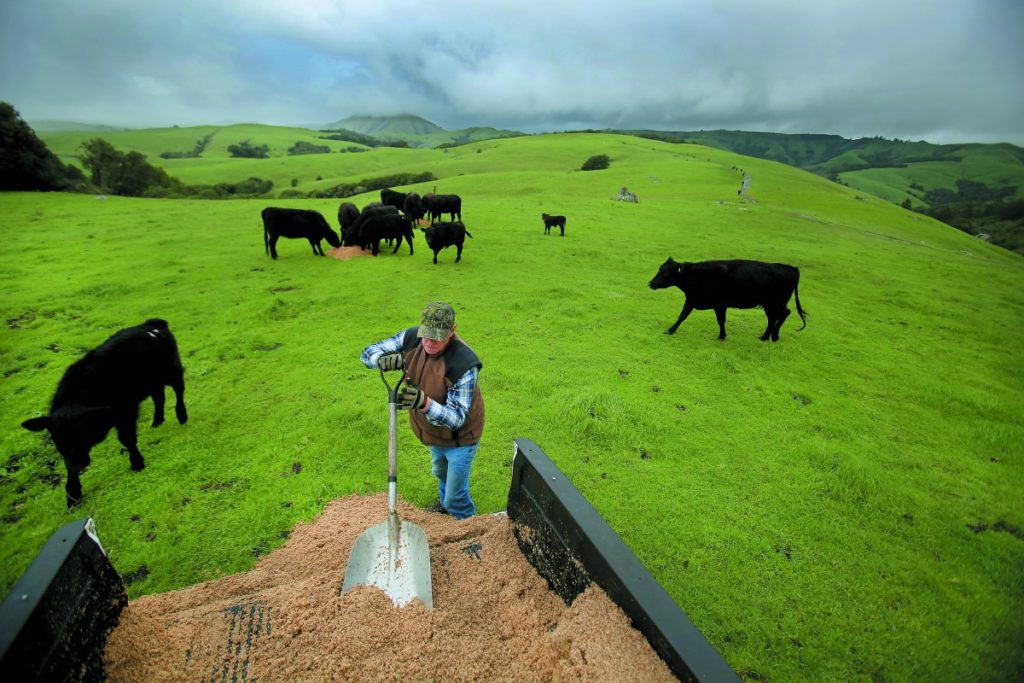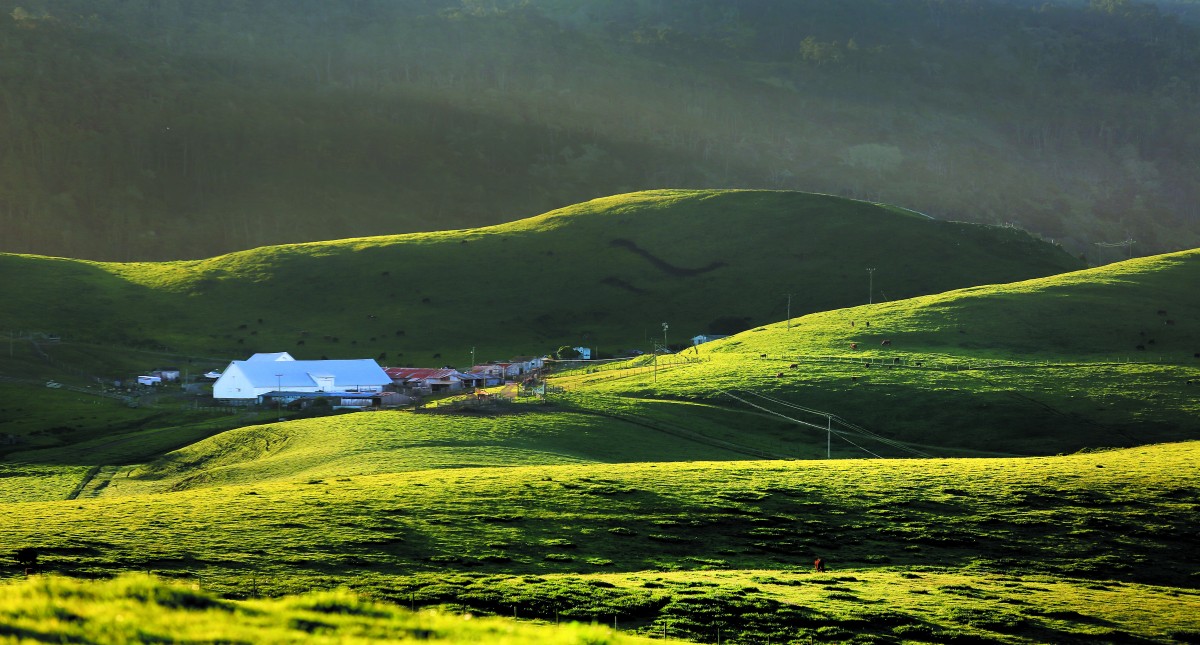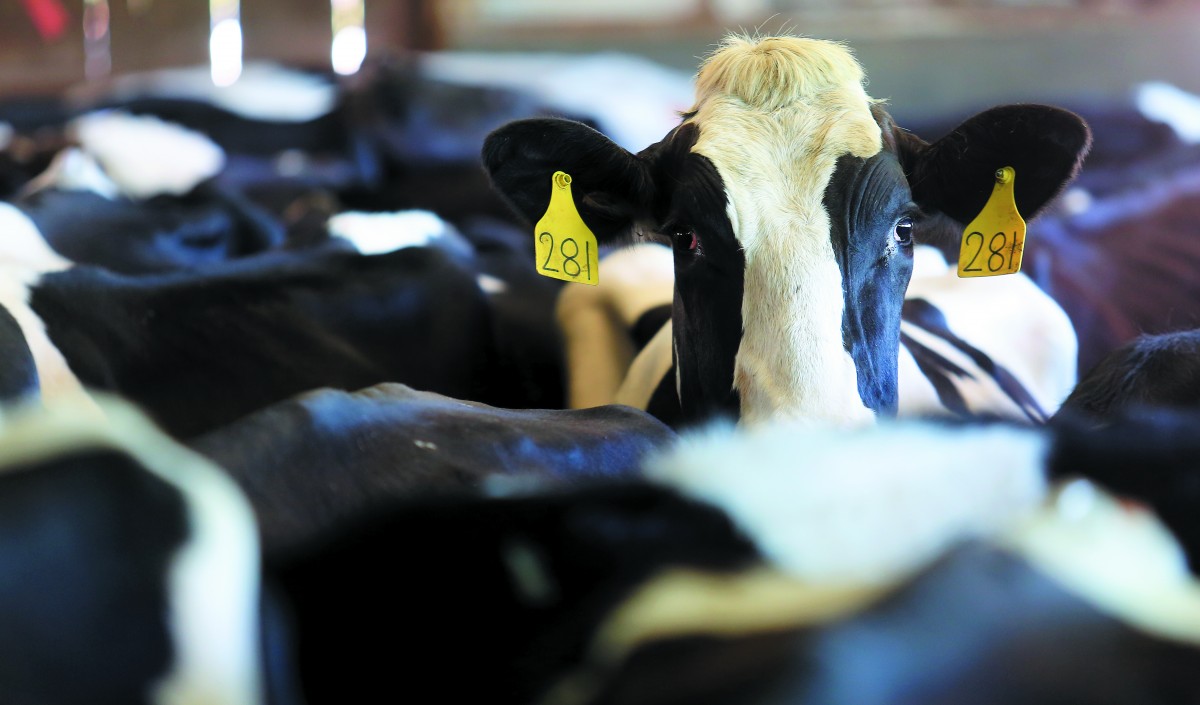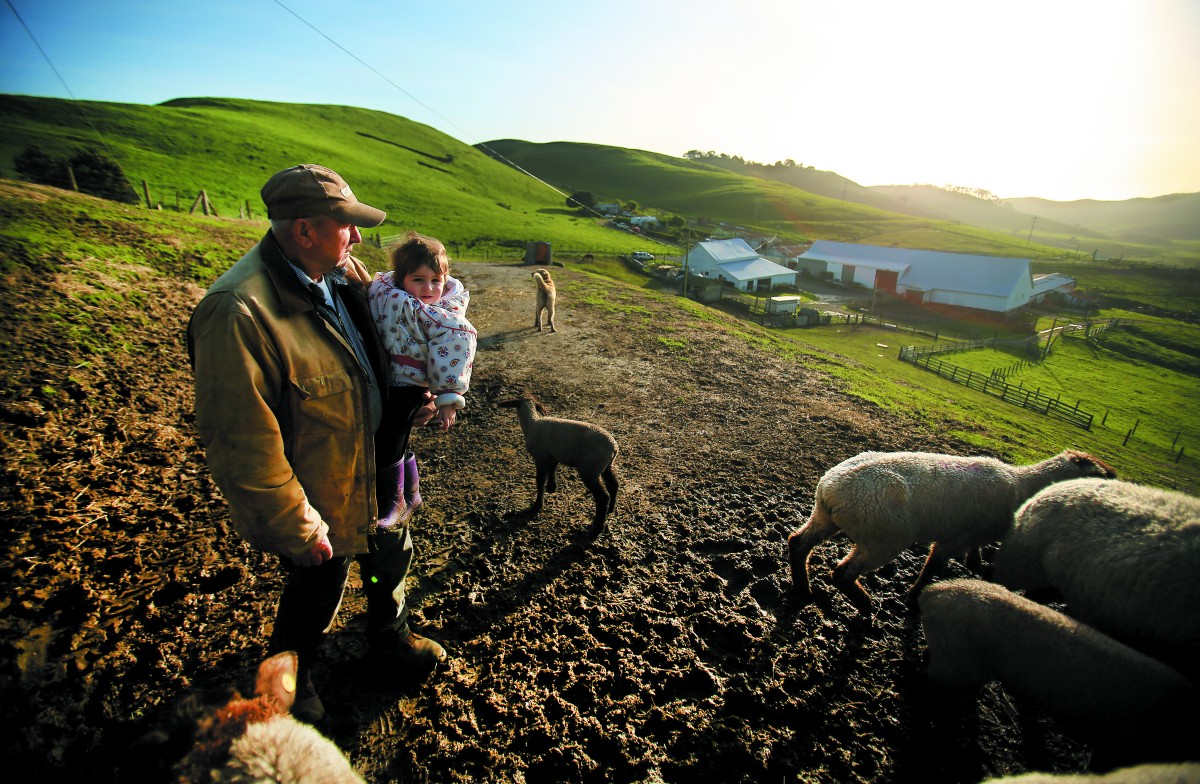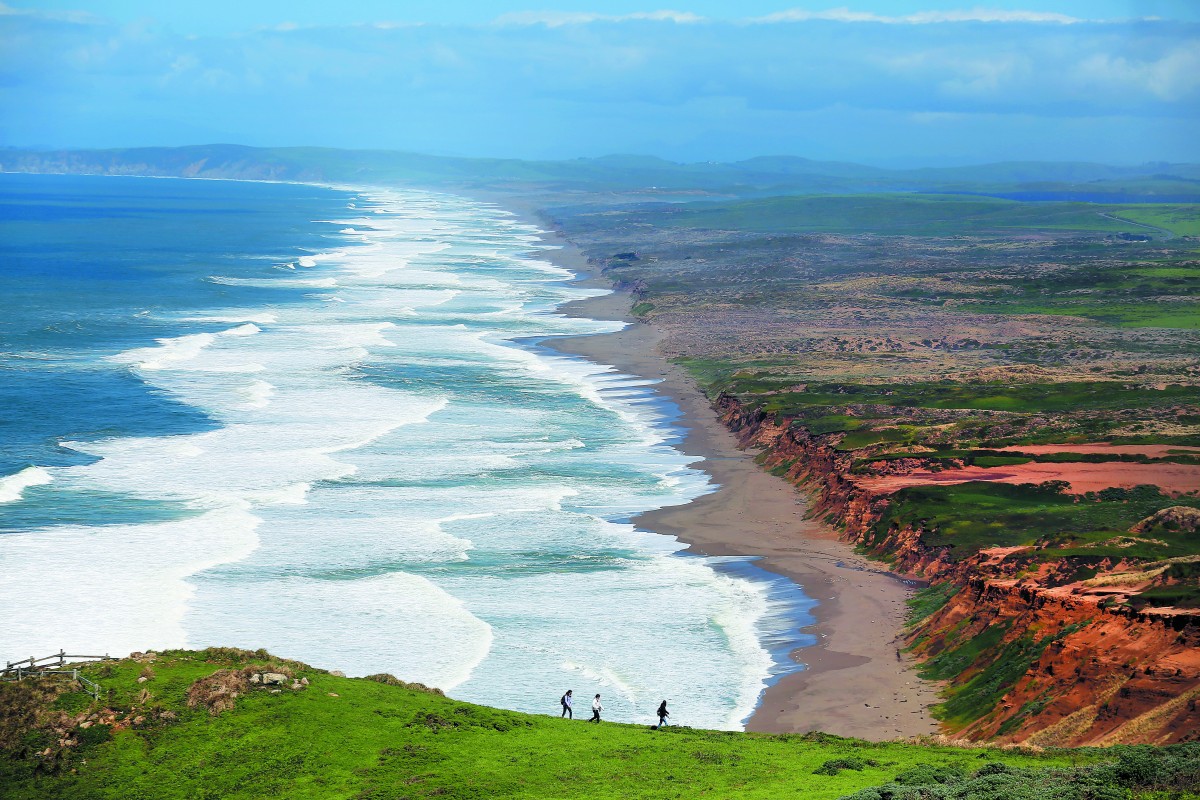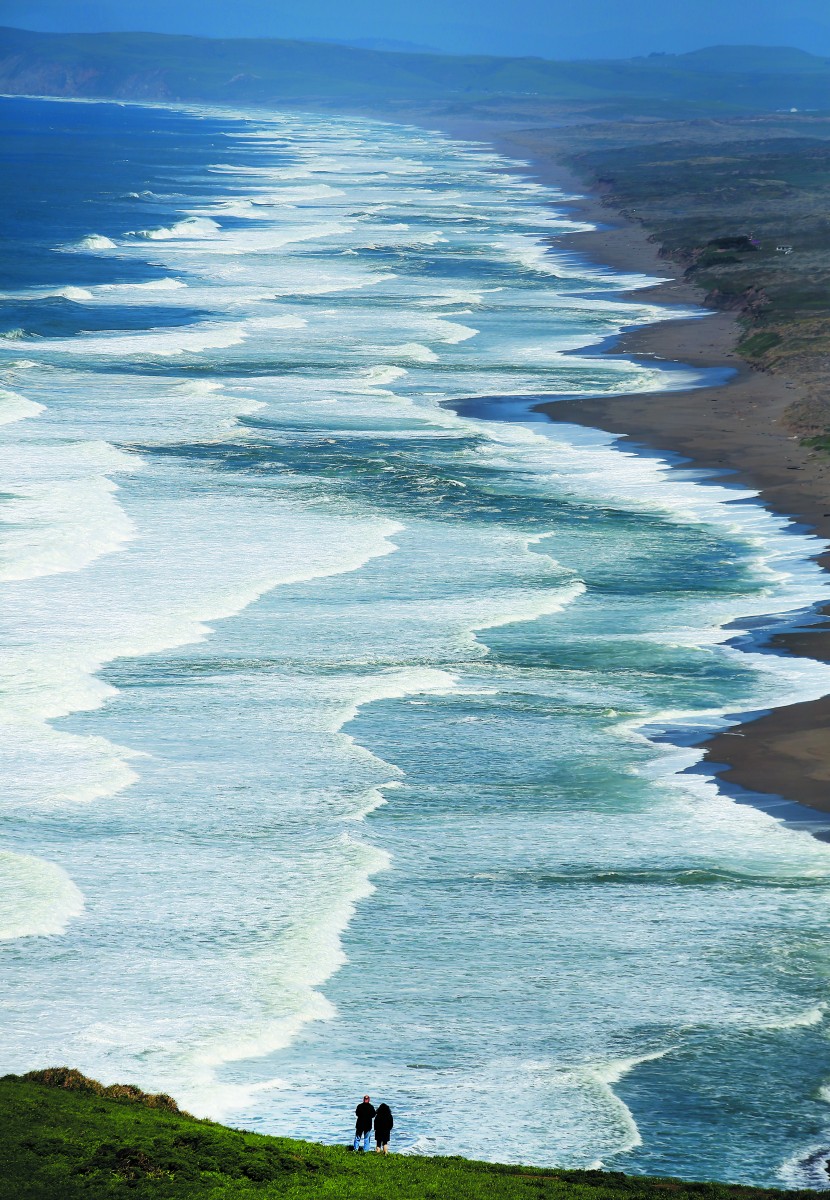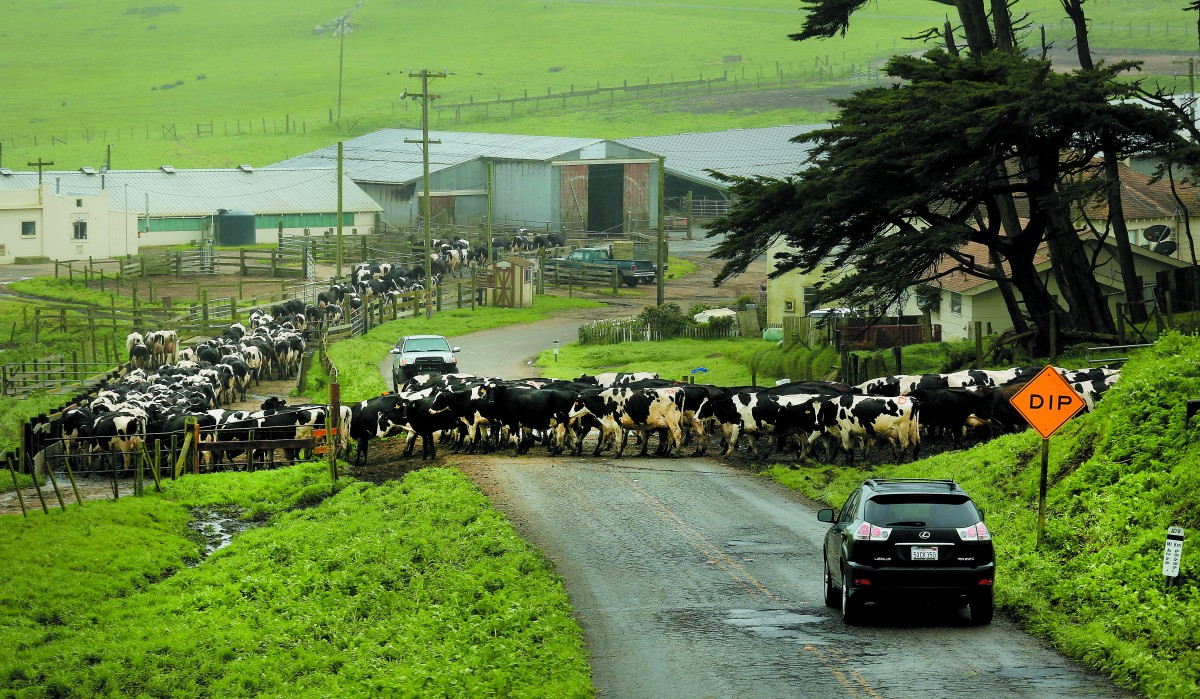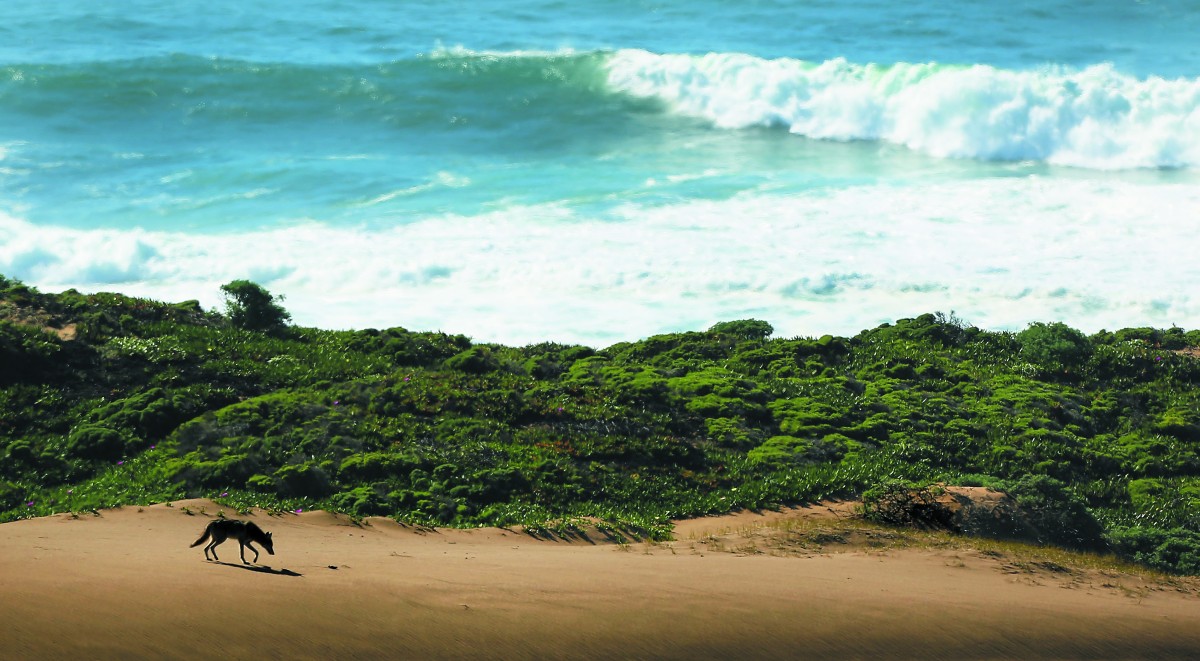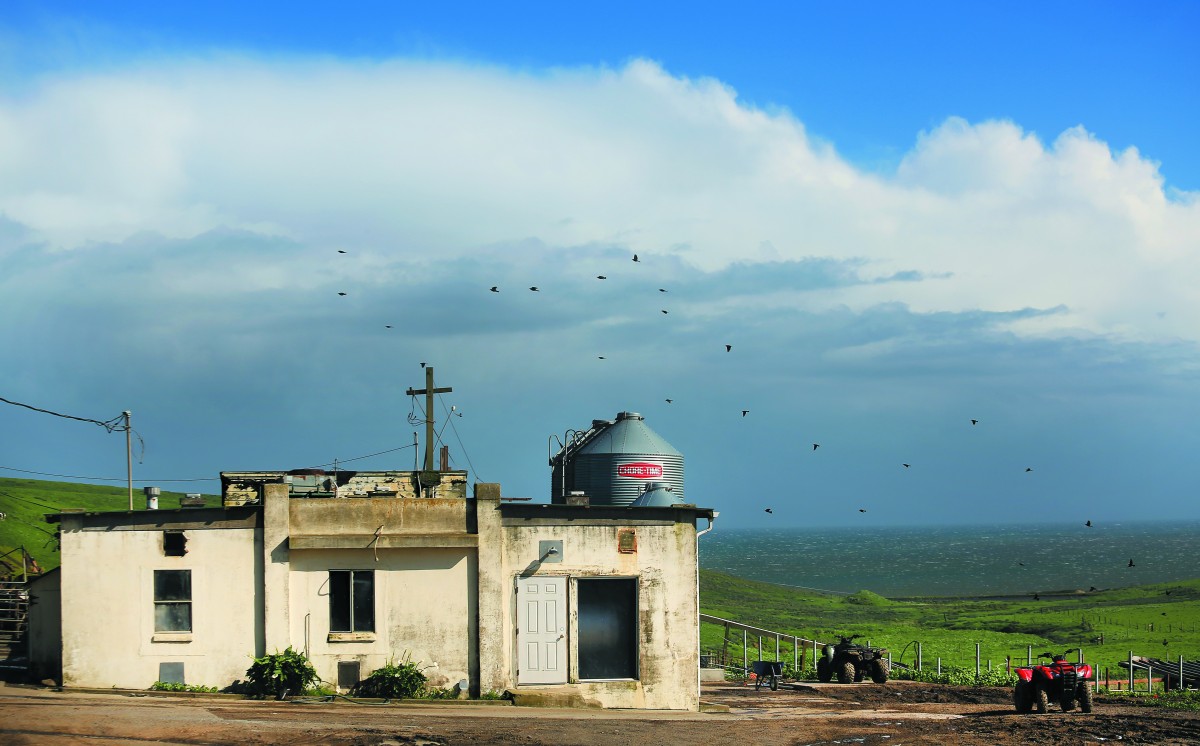Photography by Kent Porter.
Storm clouds shadowed Ted McIsaac as he shifted his battered 1994 Chevy pickup into four-wheel drive and bounced along a muddy track over hills cloaked in brilliant green grass.
His border collie Rollin trotted alongside while McIsaac made a routine morning recon of his 2,500-acre Point Reyes ranch to scan the slopes near and far for his 160 head of pure black cattle. To the west, the dark spine of Inverness Ridge framed the horizon, and two miles beyond winter surf pounded a wild coastline.
“You rely on Mother Nature. She rules your day,” said McIsaac, 65, a lean, sturdy man with a creased face and square jaw. A fourth-generation rancher, he’s accustomed to the vagaries of weather, especially spring rains that can make or break a cattleman.
But a much larger storm now hangs over the remote Point Reyes peninsula, where a legal fight triggered by three environmental groups has profoundly unsettled life for McIsaac and the 23 other families who operate ranches on the federally protected landscape.
Theirs is a way of life often as rough as the relentless waves crashing at the edges of this timeless headland. And they believe the future of ranching is at stake in the 71,000-acre Point Reyes National Seashore, where pasture for beef and dairy cattle exists side by side with wilderness, both shielded from development in a unique preserve established by the federal government at the ranchers’ behest more than 50 years ago.
President John F. Kennedy, convinced it was some sort of charmed West Coast Cape Cod, created the national park after ranchers and environmentalists fearful of intense development pressures banded together to stop the encroachment of subdivisions on Point Reyes.
As part of the deal, the ranchers insist they were made a promise specifically designed to endure: They could remain as long their families were willing to work in the wet, cold and wind of an unforgiving landscape.
Point Reyes and its landscape are the center of an unfolding dispute that ultimately seeks to define the nature of the landscape in America’s national parks: Can the treasured public scenery accommodate the country’s ranching tradition?
The lawsuit, which has drawn wide attention to the region, does not directly seek removal of the ranches but raises fundamental questions about the purpose of the seashore. It claims that the ranching that began here more than 150 years ago — and continues under leases with the federal government — is harming the wildland and wildlife the park is also supposed to safeguard.
If studies show cattle are harming the seashore they could be prohibited, said Jeff Chanin, a San Francisco attorney who represents the plaintiffs. Federal court rules require the two sides to discuss a possible settlement that would avoid a trial, he said, and a conference is set for May.
The park, just an hour north of San Francisco, includes thick conifer forests, miles of unspoiled beaches, wetlands teeming with birds and coastal bluffs where herds of massive tule elk roam. About 2.5 million visitors, including hikers and backpackers, are drawn to the spectacle every year.
Over decades, thousands of grazing cattle have trampled that habitat and polluted those waterways, say the environmental groups that sued the National Park Service in February, saying none of the ranch leases, many on 1-year terms, should be renewed without further study of their impact.
“That’s a public landscape,” said Huey Johnson, a former California secretary of resources and founder of the Trust for Public Land. He now heads the Mill Valley-based Resource Renewal Institute — one of three parties that filed the lawsuit.
Johnson said the Park Service’s management of the ranches is a travesty.
“We’ve got pastures of mud and manure instead of wildflowers,” he said.
However, for the park’s ranchers and their many allies, who extend from West Marin to Capitol Hill, the lawsuit threatens not only a way of life but a nearly unprecedented experiment in the history of the national park system – the same network that includes beloved spots such as Yosemite and Yellowstone.
With the exception of an Ohio park, no other place in the country allows working ranches within national park boundaries.
The pivot by some environmentalists against ranches in the seashore threatens to undermine the foundational deal on which the park was established, said Rep. Jared Huffman, the whose North Coast district takes in the park.
He called the lawsuit a “frontal assault on any continued agriculture in the Point Reyes National Seashore.”
“We are not going to let these ranches and dairies go on my watch,” said the Marin County Democrat, a former environmental attorney.
Were it not for the lawsuit, this would be a pretty good season for Point Reyes ranchers. The wet winter and spring have delivered a plentiful grass crop to feed their herds and a respite from the worries of several drought-plagued years that nearly doomed some outfits.
In spring 2014, McIsaac came within 45 days of going broke after buying hay most of the year to feed his cattle. Late-March rains bailed him out.
“We raise cattle but what we really do is harvest grass,” he said.
McIsaac, who carries a cigarette pack in the pocket of his fleece vest, is the great-great-grandson of a Civil War veteran who came to the Point Reyes peninsula in 1865 as California’s dairy industry — now a $9 billion a year enterprise — was getting rooted in a lush landscape once described as “cow heaven.”
Home for his family is a pale-green, two-story farmhouse, part of it built in the 1880s, all of it crying for a coat of paint. One end of the house burned in 1955 and was upgraded, but since he sold the ranch to the government in 1983, McIsaac, like the other ranchers on short leases, has little ability to borrow money and gains no equity from making improvements.
Ranchers throughout the park are in the same boat, and few complain about it. Instead, they put greater stock in their ability to diversify and broaden their future agricultural options, adding other consumer products to bolster their finances.
As far back as the 1920s, Japanese farmers grew peas and Italians raised artichokes on what is now parkland next to Drakes Estero, the large tidal waterway at the heart of the seashore.
Fast-forward nearly a century and the larger region is renowned in the food world for its grass-fed beef and organic dairy goods, launching famed Bay Area labels such as Niman Ranch, the natural meat purveyor, and Cowgirl Creamery, the artisanal Point Reyes cheesemaker. But without 20-year leases, ranchers say, they are unable to borrow money to make the improvements needed to cash in on such trends in agriculture. Jarrod Mendoza, who milks about 200 cows on B Ranch near the tip of the Point Reyes peninsula, said he needs financing to rebuild an old wooden barn that blew down during a storm in March. “You don’t want to see the book closed,” said Mendoza, whose great-grandfather acquired the 1,200acre ranch in 1919.
The trio of environmental groups suing the Park Service, however, claim that a broader range of farming at the seashore ranches – including chicken, pig and row-crop production, for example – could result in more conflicts with wildlife and wilderness in the park.
Their lawsuit has targeted the renewal of ranching leases thathey fear could pave the way for broader agricultural operations.
That process, said Jeff Miller, of the Oakland-based Center for Biological Diversity, another of the plaintiffs in the case, is “predetermined”
to favor awarding the ranchers with the long-term leases they seek.
“It hasn’t asked whether ranch leasing is appropriate,” he said.
The suit, citing reports by the Park Service, contends that grazing cattle have polluted waterways such as Drakes Estero with manure and degraded the habitat of threatened or endangered species, such as coho salmon and California red-legged frog.
Ranchers bristle at claims their operations are damaging a land- scape their families have occupied for generations.
Nicolette Niman, who runs 175 cattle on a 1,000-acre ranch in Bolinas at the southern tip of the seashore, asserted in her book, “Defending Beef,” that small-scale, well-managed ranches are good for the land. Periodically moved from one pasture to another, cattle trim the grass, press seeds into the soil and fertilize it with their urine and manure, said Niman, who bills herself as “an environmental lawyer and vegetarian turned cattle rancher.”
“Human activity isn’t hostile to the principle of preserving the land,” she said. The prehistoric Coast Miwok maintained the peninsula’s coastal prairies by setting them on fire, and cattle grazing
continues that purpose, Niman said. An end to ranching would diminish the landscape and the community, Niman said.
“The beautiful, big, open areas you can walk through” would shrink under the advance of woodland, eliminating grasslands where hawks and eagles feed. Local schools, churches and businesses would lose the support of ranching families, who are “the bedrock of West Marin,” she said. “It would be transformative.”
Allies in the worlds of land conservation and academia have chimed in to support the ranchers’ place in the park.
“You can have wild spaces and agriculture side by side,” said Laura Watt, a Sonoma State University environmental historian whose 15- year study of the seashore has focused on the region as a working landscape, with human uses and wild habitats closely intertwined.
The opposite view, one held by the plaintiffs, Watt said, is an “absolutist” division of farm- and wildland that insists parks must minimize human presence to ensure “zero impacts” on the landscape.
The mix of ranching and wildland is “part of the charm at Point Reyes” and ought to be preserved, she said.
In the real world, ranchers and their allies are also worried what a smaller footprint in the park or constrained operations would mean for the future of North Bay agriculture. Prominent Marin County conservationist Phyllis Faber, who Co-founded the Marin Agricultural Land Trust, notes that the seashore ranchers were pioneers in open space-protection in 1960s when they agreed to sell their land to the government. Farm fortunes were waning at the time and the urban Bay Area was booming, putting immense pressure on peninsula landowners to sell out to developers.
But Faber, 88, now fears that move may turn out to be the “death knell” for the ranchers.
Congress could settle the matter, and possibly stifle future lawsuits, by reaffirming the place of ranching in the seashore. “It would save the ranchers a lot of heartache,” she said.
On a clear day, Rich Grossi and his wife, Jackie, can see the ocean from the picture window of their home on M Ranch — one of 14 historic “alphabet ranches” in the seashore.
When the fog rolls in, as it does about 200 days a year, visibility shrinks to a few feet and patrols of 1,200-acre spread become a bit dicey.
A visitor would call the setting spectacular, but Grossi, hardworking at 76, scans the terrain with a different eye, seeing ranch chores almost everywhere he looks. Fence repairs are endless.
“One night I lay in bed and tried to figure out how many gates we had,” he said. “I lost count.”
Still, the business is one the Grossis plan to pass down in their family. Their daughter, Diane Turner, lives in the house next door and represents the fourth generation on M Ranch.
“We’re growing food for people,” said Turner, 50. “Not like living in town. It’s a whole ’nother world.”
The Grossis admit to being rattled by the standoff over ranching in Point Reyes. It is the latest place where tough-minded environmentalists have called for greater scrutiny over livestock grazing on public lands in the western United States.
The Center for Biological Diversity, one of the more successful and well-known among those interests, specializes in lawsuits aimed at protecting endangered species. The group’s website touts that 93 percent of its cases “result in favorable outcomes.”
The third plaintiff involved in the Point Reyes suit, the Western Watersheds Project, includes among its litigation victories a 2007 federal court ruling that threw out rancher-friendly grazing regulations established by the George W. Bush administration on more than 160 million acres of public lands in 11 states.
“They’re not playing games,” said Mclsaac, who serves as president of the Point Reyes Seashore Ranchers Association. “That’s worrisome.”
Of particular concern for the ranchers and their allies is the Park Service’s shifting stance on the place of agriculture in the seashore. The worries were fueled by a bruising, 2-year battle the agency fought to close a popular oyster farm in the seashore in 2014. The case, which oyster farmer and Point Reyes rancher Kevin Lunny lost, went all the way to the U.S. Supreme Court.
That case was different because Lunny purchased the property knowing his lease would expire. Still, it proved a searing, divisive experience for a West Marin community that prides itself on the value of both locally grown food and wild places.
Ranchers steer clear of faulting the Park Service, which is their landlord, but their allies question its commitment to agriculture. Lunny’s farm, they say, was railroaded out of the seashore after the agency became determined to end an 80-year history of oyster cultivation in 2,500-acre Drakes Estero.
In the case of the beef and dairy ranchers, Watt suggested the oyster war could predispose the Park Service to settle for “some kind of compromise” on leases rather than wage a long legal battle.
Nevertheless, the parks agency, even during that prolonged fight over the Drakes Bay Oyster Co., has sought to clarify that the seashore’s ranches are not in its sights and have a solid place in the park.
“Ranching is integral to our history and to our future here at Point Reyes National Seashore,” Park Superintendent Cicely Muldoon said in a press release in April 2014 at the start of a lengthy planning process. “For more than 50 years, ranchers and the park have been working together. This plan is an opportunity to build on that past, address current issues and strengthen our shared stewardship of these lands.”
The pact struck by ranchers years ago in the seashore’s formation ought to provide some reassurance that grazing and wilderness can continue to exist side by side, Muldoon said in an interview. “I don’t see it as a conflict at all at Point Reyes,” she said.
Environmental groups have succeeded before in removing cattle from a national park in California. A 1996 lawsuit by the National Parks Conservation Association culminated in a settlement that stopped grazing on Santa Rosa Island, which had become part of the Channel Islands National Park off the Santa Barbara County coast 10 years earlier.
The association, a group that acts as an environmental watchdog, parks lobbyist and sometime-litigant against the Park Service, said cattle grazing in that instance was harming the island’s ecology, along with a trophy-hunting operation.
The group also pushed aggressively for the ouster of the Drakes Bay Oyster Co., noting that the estero in which it operated was designated to become wilderness in 2012 when the farm’s 40-year permit was set to expire.
But in the current case, the group is backing agriculture in the ranch planning process.
“We support the combination of ranching and the seashore,” said Neal Desai of the National Parks Conservation Association. “We think that’s possible.”
Also supporting the ranchers is the powerful California Cattlemen’s Association, which represents the state’s $3 billion beef cattle industry.
The group has “butted heads plenty of times” with the Center for Biological Diversity in and out of court, said Kirk Wilbur, director of government affairs.
The latest lawsuit was no surprise, he said, in the wake of the oyster farm’s ouster. “It’s a pretty transparent attempt by radical environmental groups to get grazing off the landscape,” he said.
The plaintiffs insist that is not the goal of their lawsuit, calling such assertions “sensationalist.”
“There’s no call to an end to ranching in the litigation,” said Chance Cutrano of the Resource Renewal Institute, the group headed by Johnson, 83, the former state resources secretary and a widely respected figure in environmental circles.
Instead, the claimants want the Park Service to assess the impacts of ranching and devise a plan to address them, Cutrano said.
Whether ranching continues and what the conditions might be is “not up for us to decide,” he said.
For nature lovers savoring the spring wildflowers at Chimney Rock, panoramic views from Mount Vision and the stunning vista at 11-mile Point Reyes Beach, the national seashore offers the balm of wilderness. But those visitors, according to the Park Service’s own description, have “happened upon one of the earliest and largest examples of industrial-scale dairying in the state of California.”
Hikers heading to the four backcountry campgrounds feel they have found refuge from urban hubbub, but all of them are located on the site of vanished dairies. At Sky Camp, located near the summit of 1,407-foot Mount Wittenberg, large fir, cypress and eucalyptus trees mark the location of a dairy that milked 75 cows and made a ton of butter a month in 1901, according to local historian Dewey Livingston’s book, “Ranching on the Point Reyes Peninsula.”
When the national seashore was established in 1962, there were ranches and roads throughout the peninsula. Many have since been erased by the Park Service.
“The wilderness area is an artificially created and managed setting of pristine-ness, disregarding the actual history of the place,” Watt, the Sonoma State historian, said in a 2002 article.
Wild or not, it was a landscape and a way of living that called McIsaac back four decades ago, a few years after he’d bolted from the family ranch, convinced he never wanted to look at another milk cow.
He returned in 1975, working for his father, and he took over the ranch about 15 years later.
“I can’t imagine doing anything else,” he said, his stained work jeans and worn ball cap evidence of a long days spent outdoors.
The rhythms of daily life for McIsaac and fellow park ranchers are largely imposed by sunup-to-sundown chores and the harsh elements. Point Reyes is the second-foggiest place in North America, behind Grand Banks, Newfoundland, and the windiest spot on the Pacific Coast.
But beyond the weather, when ranchers find time these days to meet up, their talk inevitably turns to the lawsuit over their leases.
The discussion is filled with uncertainties, weightier even than those that usually dog them. Families with four and five generations of working the land worry that their dream of passing it on to their children and grandchildren won’t come to pass.
Rich Grossi, who has no plans to retire, said his family has put off talking about who will take over M Ranch when he does step back. “We’re kind of cooling it now to see if we’ve got a leg to stand on,” he said.
Settled in the comfortable ranch house kitchen, Jackie Grossi said the future is out of their hands.
“We don’t know where it’s going to lead,” she said. “It’s heartbreaking.”










